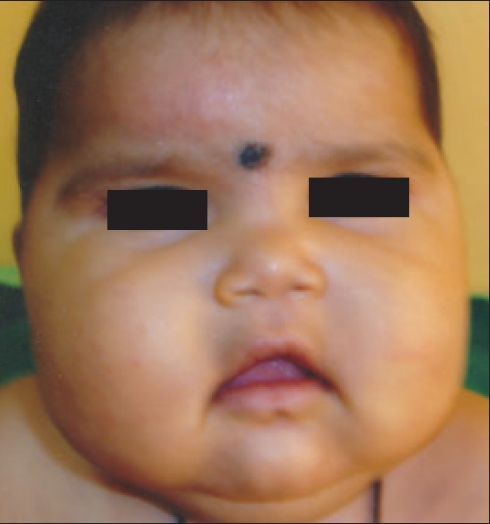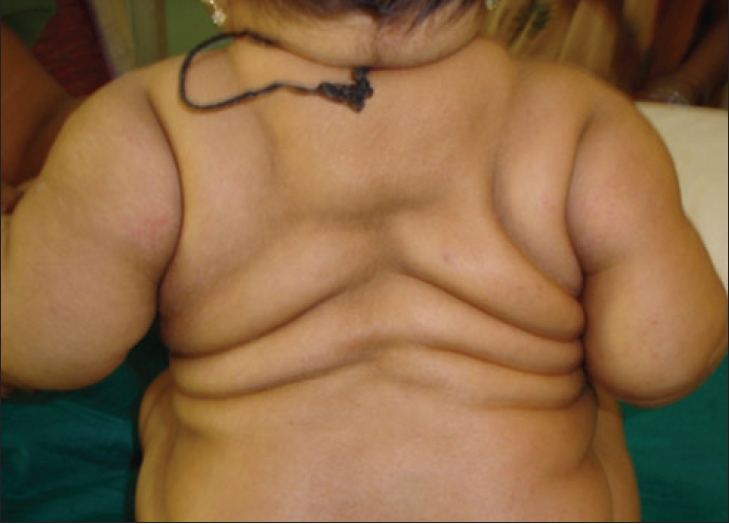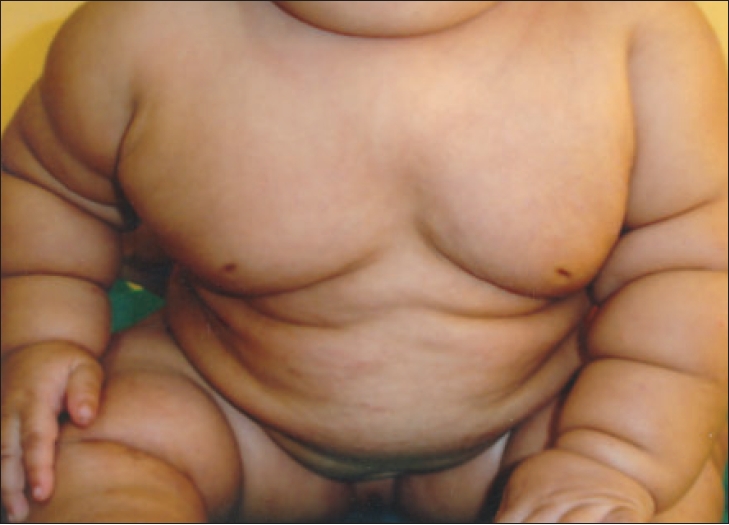Translate this page into:
Circumferential skin folds in a child: A case of Michelin tire baby syndrome
Correspondence Address:
Arun C Inamadar
Department of Dermatology, Venereology and Leprosy, BLDEA's SBMP Medical College, Hospital and Research Center, Bijapur - 586103, Karnataka
India
| How to cite this article: Palit A, Inamadar AC. Circumferential skin folds in a child: A case of Michelin tire baby syndrome. Indian J Dermatol Venereol Leprol 2007;73:49-51 |
Abstract
A six-month-old girl who presented with dermatitis was found to have multiple, symmetric, deep, gyrate skin folds involving her trunk and similar circumferential lesions on her extremities since birth. She had a characteristic round face with hypertelorism, depressed nasal bridge, thin, down-turned vermillion border of upper lip and short neck. Skin biopsy demonstrated increased smooth muscle fibers in the deeper dermis. A diagnosis of Michelin tire baby syndrome was made. Clinical features, histopathology, differential diagnosis and prognosis of this rare disorder have been discussed. |
| Typical facies with hypertelorism, depressed nasal bridge and down-turned upper lips |
 |
| Typical facies with hypertelorism, depressed nasal bridge and down-turned upper lips |
 |
| Symmetrical gyrate skin creases on back |
 |
| Symmetrical gyrate skin creases on back |
 |
| Deep ring-like folds over extremities |
 |
| Deep ring-like folds over extremities |
Introduction
Circumferential skin fold is a rare finding at birth. One or few constrictions involving the limbs may be part of amniotic band sequence. Multiple, symmetric, ring-like lesions involving the extremities and trunk are seen in a benign hamartomatous condition of the skin known as Michelin tire baby syndrome (MTBS). It is a rare genodermatosis (MIM % 156610), approximately 20 cases of which have been reported to date.[1] The detailed description of this condition was given by Ross in 1969.[2] However, Wiedemann has described this as ′a congenital anomaly existing from the beginning of the mankind′ as this feature was depicted in the son of Eve in a bronze door inscription at the cathedral of Hildesheim in northwestern Germany.[3]
Case report
A six-month-old female child with a clinical suspicion of Cushing′s syndrome was referred from the Department of pediatrics for the management of itchy skin lesions. The child had an intensely pruritic, oozy dermatitis involving the face and extensor extremities. In addition, there were multiple, symmetric, deep, gyrate skin folds involving her trunk and similar circumferential lesions on her extremities [Figure - 1],[Figure - 2]. She had a characteristic round face with hypertelorism, depressed nasal bridge, thin, down-turned vermillion border of upper lip and short neck [Figure - 3]. The folds were present since birth and were asymptomatic without causing any physical discomfort to the child. The parents did not have any complaint regarding these as it was perceived by them as a sign of good health.
She did not have any major illness in the past necessitating prolonged treatment. Though there was a resemblance to Cushing′s syndrome, detailed examination did not reveal any features suggestive of this condition. Her body weight was 8.5 kg. Other anthropometric measurements were within normal limits and developmental milestones were normal. Several of her family members had history of atopy but none had similar skin folds.
A diagnosis of MTBS was made. A skin biopsy was done from a deep fold on the right arm. Histopathology (H and E) showed normal epidermis and papillary dermis. There were scattered bundles of smooth muscle fiber in the reticular dermis. Masson trichrome stain revealed presence of increased smooth muscle fibers.
The child′s dermatitis improved with a short course of systemic steroids, antihistamines and emollients. The cause and nature of the skin folds were discussed with the parents and they were counseled about the self-limiting course of this disorder.
Discussion
Ross coined this descriptive name ′MTBS′ because of the physical resemblance of these patients to the mascot of a French tire manufacturer.[2] It is a hamartomatous disorder involving either adipose tissue or smooth muscle in the deeper dermis of the skin.
The condition may be familial and there is evidence of autosomal dominant mode of inheritance affecting several members in successive generations of a family.[4] The pathogenesis is yet unclear; chromosomal anomalies detected in this condition are deletion of the short arm of chromosome 11[5] and paracentric inversion of the long arm of chromosome 7.[6] Multiple, asymptomatic, circumferential folds, simulating skin bands are the most prominent feature of MTBS. These are usually present since birth. Extremities are the commonest sites of involvement, others being the trunk, palms and soles. Hypertrichosis of the involved areas may be observed.[7],[8]
Multiple congenital anomalies have been described as associations. These include facial dysmorphism, as described in our patient, long and curled eyelashes, bushy eyebrows and bilateral epicanthic folds.[8] Low-set ears, cleft lip and palate, hypoplastic teeth and mandible may be present.[8] Other features include developmental delay, seizure disorders, pectus excavatum, congenital heart defect and undescended testis with abnormal histology.[3],[8],[9]
The cause of the dermatomegaly may be a diffuse lipomatous nevus involving the deeper dermis as reported in the first patient.[2] Hence the name ′congenital diffuse lipomatosis′ has been attributed to this condition.[2],[8] Underlying smooth muscle hamartoma may be present[8] as seen in the index case. Scarring, instead of increased adipocytes or muscle fibers has been reported.[10] Sato et al .[11] have reported fragmentation of elastic fibers in addition to increased smooth muscle tissue in their patient and suggested that abnormal elastic fiber formation may be a pathogenetic factor in this condition.
The affected children are otherwise normal. The skin folds gradually diminish and disappear without any intervention.[8],[12] In familial cases, older family members may show few remnants of deep skin folds.
Congenital amniotic bands are usually solitary and present on limbs. These may be part of amniotic band sequence, present in association with multiple congenital anomalies. Beare-Stevenson cutis gyrata syndrome is associated with dermatomegaly which is localized to the scalp, forehead, face and neck.[13] Some authors believe that MTBS may not be a single disorder but a clinical finding associated with many other conditions.[13]
Circumferential skin creases have been included as a component of some recently described entities like HITCH syndrome (Hearing Impairment, undescended Testis, Circumferential skin creases and mental Handicap)[14] and multiple congenital anomalies and mental retardation (MCA/MR) syndrome.[15]
One patient of MTBS has been reported from India, who had mild affection and there was spontaneous involution of the skin creases during childhood.[12] Our patient has been kept under regular follow-up for the evaluation of course of the disease.
| 1. |
Kharfi M, Zaraa I, Chaouechi S, Zekri S, Boukef S, Jaafoura H, et al . Michelin Tire syndrome: A report of two siblings. Pediatr Dermatol 2005;22:245-9.
[Google Scholar]
|
| 2. |
Ross CM. Generalized folded skin with an underlying lipomatous nevus: "The Michelin tire baby." Arch Dermatol 1969;100: 320-3.
[Google Scholar]
|
| 3. |
Wiedemann HR. Multiple benign circumferential skin creases on limbs - a congenital anomaly existing from the beginning of the mankind. Am J Med Genet 1987;28:225-6.
[Google Scholar]
|
| 4. |
Bass HN, Caldwell S, Brooks BS. Michelin tire baby syndrome: Familial constriction bands during infancy and early childhood in four generations. Am J Med Genet 1993;45:370-2.
[Google Scholar]
|
| 5. |
Gardner EW, Miller HM, Lowney ED. Folded skin associated with underlying nevus lipomatosus. Arch Dermatol 1979;115:978-9.
[Google Scholar]
|
| 6. |
Schnur RE, Herzberg AJ, Spinner N, Kant JA, Magnusson M, McDonald-McGinn D, et al . Variability in the Michelin tire syndrome. A child with multiple anomalies, smooth muscle hamartoma, and familial paracentric inversion of chromosome 7q. J Am Acad Dermatol 1993;28:364-70.
[Google Scholar]
|
| 7. |
Glover MT, Malone M, Atherton DJ. Michelin tire baby resulting from diffuse smooth muscle hamartoma. Pediatr Dermatol 1989;6:329-31.
[Google Scholar]
|
| 8. |
Wratchford T, Kamat D, Cohen B. Something's "going around": Skin creases on a baby's limbs. Contemp Pediatr 2003;20:30.
[Google Scholar]
|
| 9. |
Cooper CS, Noh PH, Zderic SA, Huff DS. Abnormal testicular histology in Michelin tire syndrome (Abstract). Clin Dysmorphol 2001;10:75-6.
[Google Scholar]
|
| 10. |
Burgdorf WH, Doran CK, Worret WI. Folded skin with scarring: Michelin tire baby syndrome? J Am Acad Dermatol 1982;7: 90-3.
[Google Scholar]
|
| 11. |
Sato M, Ishikawa O, Miyachi Y, Aoki T, Tomomasa T, Nagashima K. Michelin Tyre syndrome: A congenital disorder of elastic fibre formation? Br J Dermatol 1997;136:583-6.
[Google Scholar]
|
| 12. |
Sardana K, Mendiratta V, Kakar N, Sharma RC, Koranne RV, Sethi S. Spontaneously improving Michelin tire baby syndrome. Pediatr Dermatol 2003;20:150-2.
[Google Scholar]
|
| 13. |
Burgdorf WH, Ruiz-Maldonado R. Benign and malignant tumors. In : Schachner LA, Hansen RC, editors. Pediatric Dermatology. 3rd ed. Edinburgh: Mosby; 2003. p. 863-99.
[Google Scholar]
|
| 14. |
Kondoh T, Eguchi J, Hamasaki Y, Doi T, Kinoshita E, Matsumoto T, et al . Hearing impairment, undescended testis, circumferential skin creases and mental handicap (HITCH) syndrome: A case report. Am J Med Genet 2004;125:290-2.
[Google Scholar]
|
| 15. |
Elliott AM, Ludman M, Teebi AS. New syndrome? MCA/MR syndrome with multiple circumferential skin creases. Am J Med Genet 1996;62:23-5.
[Google Scholar]
|
Fulltext Views
5,988
PDF downloads
2,699





